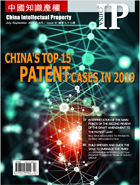This case not only confirms that the interpretation of claims is a legal issue, but also establishes the principle of the court of second instance actively reviewing the interpretation of claims of the original court, that is, no matter whether the parties object the interpretation of the claims of the original court during the second instance, the court of the second instance should take the initiative to review, and if it finds that the court of first instance did not interpret it properly, it should point it out and correct it.
First trial case number: (2016) Shanghai People’s Court 73 Civil Preliminary Judgement No. 859
Second instance case number: (2019) Supreme People’s Court Intellectual Property Administrative Final Judgement No. 2
【The main takeaway of the trial】
If a certain technical feature of a claim of a patent has defined or implied a specific structure, component, procedures, conditions or the mutual relationship thereof, even if the technical feature also limits the function or effect it achieves, it is not a functional feature.
【Case Introduction】
Appellant (Defendant in the original trial): Xiamen Lukasi Automobile Parts Co., Ltd. (referred to as Lukasi Company)
Appellant (Defendant in the original trial): Xiamen Fuke Automobile Parts Co., Ltd. (referred to as Fuke Company)
Appellee (plaintiff in the original trial): VALEO SYSTEMES D'ESSUYAGE (referred to as Valeo Company)
Defendant at first trial: Chen Shaoqiang
Valeo Company is the patentee of the invention patent involved in the "wiper connector and corresponding connection device of the motor vehicle". Claim 1 of this patent contains such a technical feature: "In the closed position, the safety buckle extends facing the locking element for preventing elastic deformation of the locking element and locking the connector, while the open position can release the connector from the wiper arm."
Valeo Company filed a request to the court of the first instance: order Lukasi Company, Fuke Company and Chen Shaoqiang to stop the infringement immediately, that is, Lukasi Company and Fuke Company immediately stopped manufacturing, selling and promising to sell the alleged infringing product, Chen Shaoqiang immediately stop manufacturing and selling the alleged infringing product; order Lukasi Company, Fuke Company and Chen Shaoqiang to destroy the manufactured infringing product and related physical objects and materials such as equipment, molds, and drawings used to manufacture the alleged infringing product; order Lukasi Company, Fuke Company and Chen Shaoqiang to jointly pay a compensation of 5 million yuan and a reasonable expense of 1 million yuan for the reasonable expenses to stop the infringement; order all litigation fees and security fees in this case will be jointly borne by Lukasi Company, Fuke Company and Chen Shaoqiang. In the process of the original trial, Valeo Company requested the court of the original trial to confirm that the alleged infringing product fell within the protection scope of claims 1-10 of the invention patent involved, and first decided to stop the defendant's infringement of the patent right immediately.
The Shanghai Intellectual Property Court believed that the technical feature of "in the closed position, the safety buckle extends facing the locking element for preventing elastic deformation of the locking element and locking the connector" is a functional feature and made the judgement that Lukasi Company, Fuke Company shall immediately stop the infringement of the patent right of the invention involved as soon as the judgment becomes effective. Lukasi Company, Fuke Company refused to accept and appealed to the Supreme People's Court.
The second instance of the Supreme People’s Court held that the alleged infringing product has the features of “in the closed position, the safety buckle extends facing the locking element for preventing elastic deformation of the locking element and locking the connector”. The court of first instance determined that the above-mentioned features were functional features. Although the application of the law was incorrect, it did not affect the result of the infringement judgment in this case. Therefore, the alleged infringing product falls within the scope of protection of the patent claims involved, and the appellant’s corresponding grounds for appeal cannot be established and will not be supported.
【Typical meaning】
According to the first paragraph, Article 8 of the Interpretation (II) of the Supreme People's Court on Several Issues concerning the Application of Law in the Trial of Patent Infringement Dispute Cases, functional features means the technical features which define the structures, components, procedures, conditions or the mutual relationship thereof, among others, through their functions or effects in invention and creation. However, a certain technical feature of the claims of the patent involved may not only define or imply the specific structures, components, procedures, conditions or the mutual relationship thereof, but also define the function or effect achieved by it. As to whether this technical feature is a functional feature, there are differences in the determination of judicial practice, and may even affect the result of infringement determination in individual cases.
It should also be pointed out that the court of the second instance specifically emphasized in this case that although the parties did not object the original court’s determination that the above-mentioned features are functional features, the interpretation of the claims is a legal issue, and the functional features and other types of technical features and there are obvious differences in the method of infringement comparison between functional features and other types of technical features, which may affect the result of an infringement judgment, so this court specifically points out and corrects it. It can be seen that this case not only confirms that the interpretation of claims is a legal issue, but also establishes the principle of the court of second instance actively reviewing the interpretation of claims of the original court, that is, no matter whether the parties object the interpretation of the claims of the original court during the second instance, the court of the second instance should take the initiative to review, and if it finds that the court of first instance did not interpret it properly, it should point it out and correct it.




